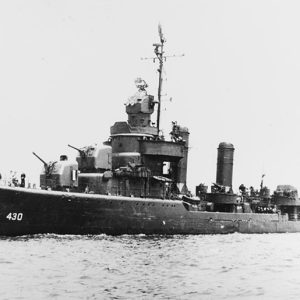calsfoundation@cals.org
USS Eberle (DD-430)
The USS Eberle was a Gleaves-class destroyer that saw service in World War II and in the Greek navy. It is one of two ships named after Admiral Edward Eberle, a resident of Fort Smith (Sebastian County), that saw service in World War II.
The keel of the ship was laid down by the Bath Iron Works in Bath, Maine, on April 12, 1939. Launched on September 14, 1940, it was commissioned on December 4 of the same year. The ship was sponsored by Mildred Eberle, the granddaughter of Admiral Eberle. The first commander of the Eberle was Lieutenant Commander Edward Randolph Jr. The Eberle was armed with four single-mount five-inch guns. (Some members of the Gleaves class had five guns, while others had only four.)
The crew of the Eberle underwent a training mission along the East Coast and in the Caribbean before being assigned to patrol duty off of Bermuda. In August 1941, the ship began serving as a convoy escort in the North Atlantic. The Eberle served mostly on the western side of the Atlantic, escorting convoys to Newfoundland and Iceland, but it made at least one trip to Scotland. Additional escort missions saw the ship visit Brazil and Trinidad, among other locations.
On October 25, 1942, the Eberle steamed from Norfolk, Virginia, to take part in the invasion of North Africa. On November 8, the ship helped shell Mehedia, French Morocco. After returning to the United States, the ship was assigned to the South Atlantic patrol in Brazil. On March 10, 1943, the Eberle and the USS Savannah encountered a German raiding ship. A Dutch commercial cargo ship that had been captured by the German navy, the Karin served as a blockade runner and surface raider. Stopping after shots were fired across the bow, a crew from the Eberle took a small boat over to German ship. As it approached, several explosions tore through the Karin as demolition charges set by its crew detonated. Several sailors from the Eberle were killed. The remaining members of the party boarded the ship and gathered documents until forced to abandon the vessel due to growing fires. The surviving members of the boarding party and seventy-two crew members of the Karin were rescued by the Savannah.
Returning to the United States, the ship underwent an overhaul at Charleston, South Carolina, before making a series of voyages between various ports in the United States and North Africa. Arriving at Naples, Italy, on March 11, 1944, the Eberle patrolled the harbor and repelled an attack by German E-boats on the night of April 20. The Eberle sank one enemy craft and forced three others to be beached.
Participating in Operation Dragoon, the invasion of southern France in the summer of 1944, the Eberle shelled the German-held port of Ile de Porquerolles until a total of seventy-two Germans surrendered. Undergoing an overhaul in New York in late 1944 and early 1945, the Eberle steamed to the Pacific, where the ship joined a group headed by the USS Antietam. Serving in Hawaiian waters when the Japanese surrendered, the ship visited both Alaska and Petropavlovsk, USSR, before the end of the year. The Eberle received three battle stars for its service in World War II. Returned to the East Coast, the Eberle was placed in a reserve commission status on June 3, 1946. On August 12, the ship was assigned to the Naval Reserve and transferred to New York. The Eberle was used by the Naval Reserve for cruises to various points for the next three years before finally being decommissioned on January 22, 1951, in Boston.
The ship was transferred to Greece, where it was renamed the Niki and served until being scrapped in 1972.
During World War II, the USS Admiral E. W. Eberle, also named for Eberle, also served in the U.S. Navy.
For additional information:
Dictionary of American Naval Fighting Ships. Washington DC: Navy Department, Office of the Chief of Naval Operations, Naval History Division, 1959–1981.
David Sesser
Henderson State University
 Military
Military World War II through the Faubus Era, 1941 through 1967
World War II through the Faubus Era, 1941 through 1967 Edward Walter Eberle
Edward Walter Eberle  USS Eberle
USS Eberle 




Comments
No comments on this entry yet.